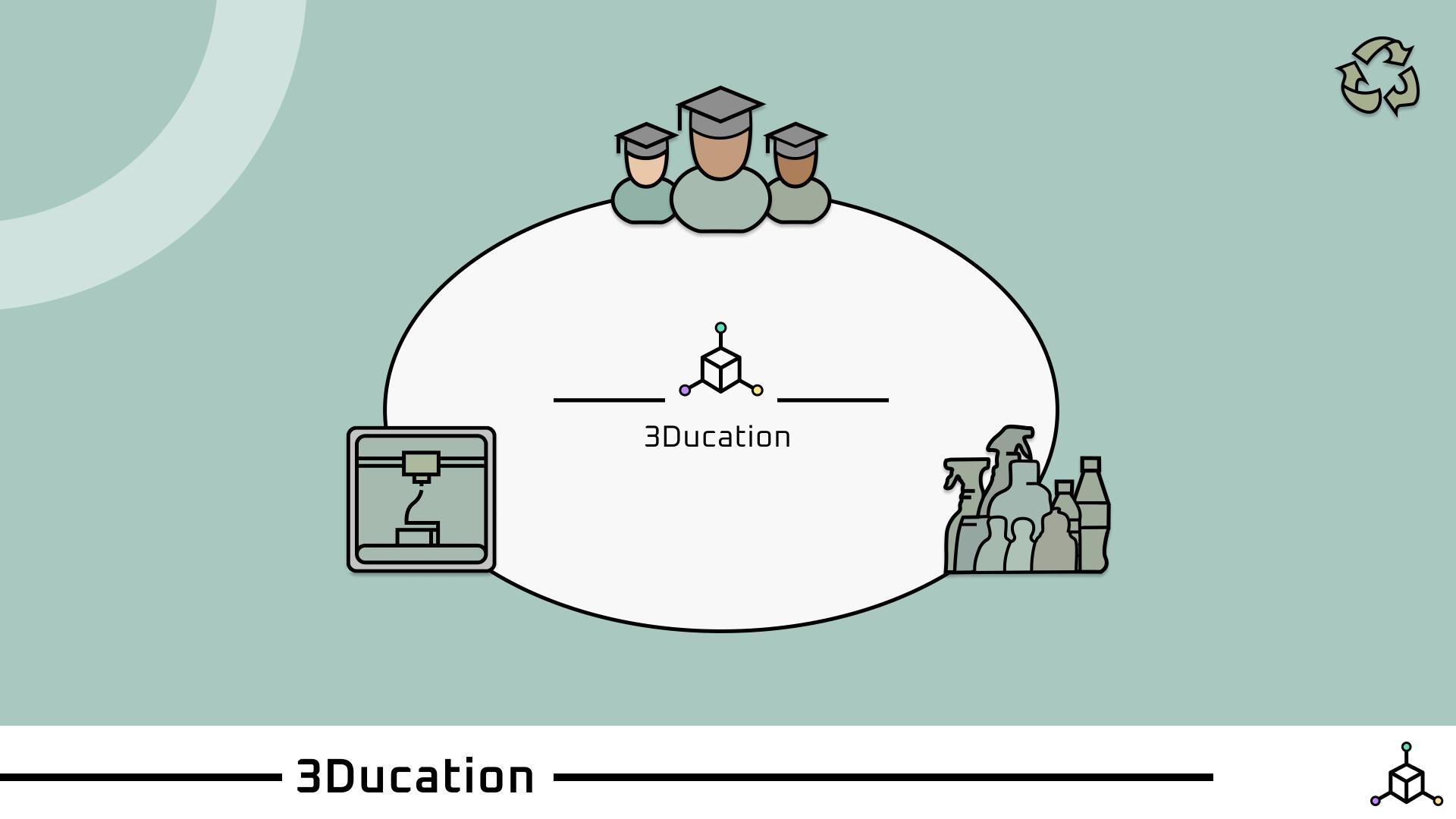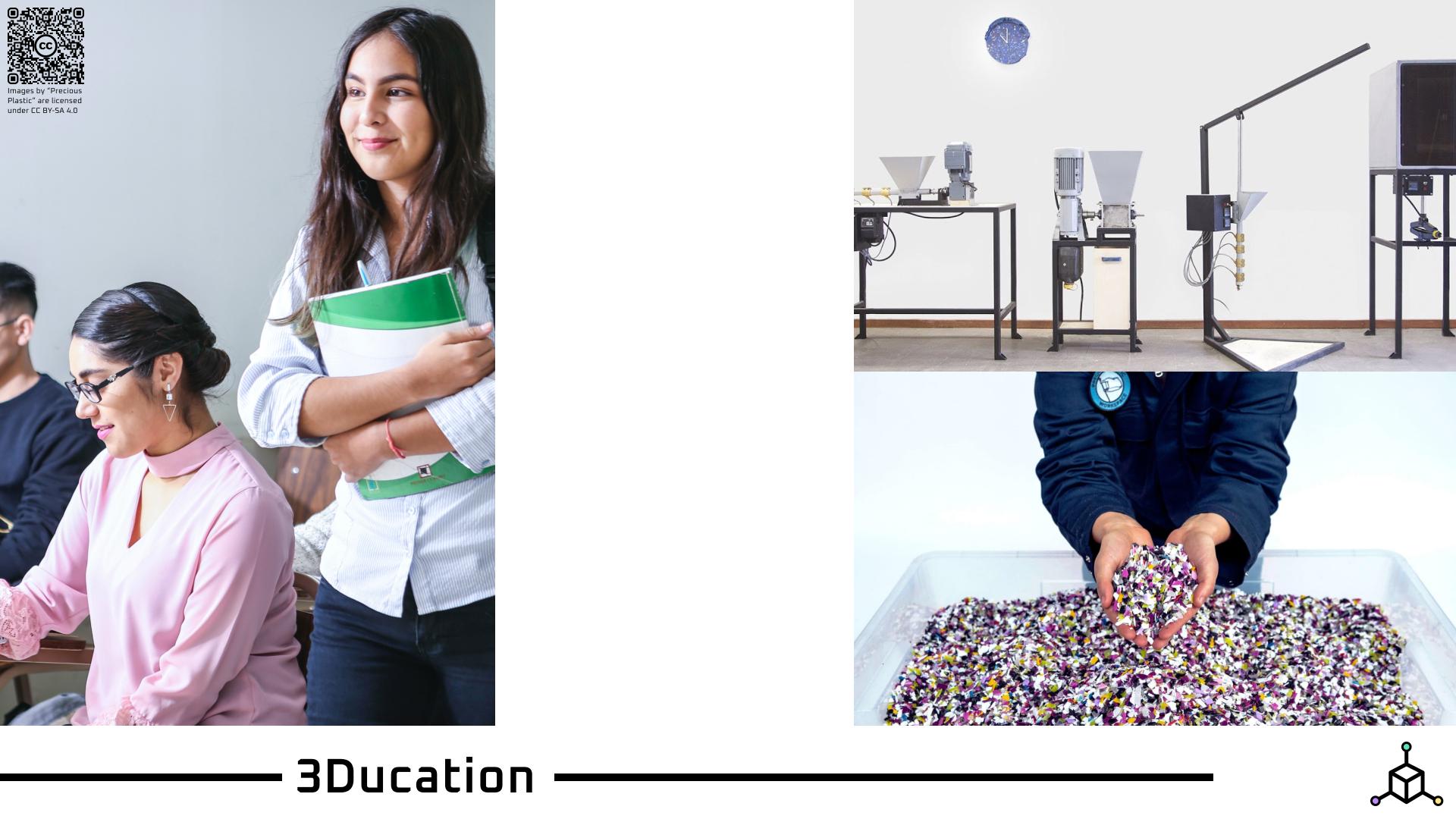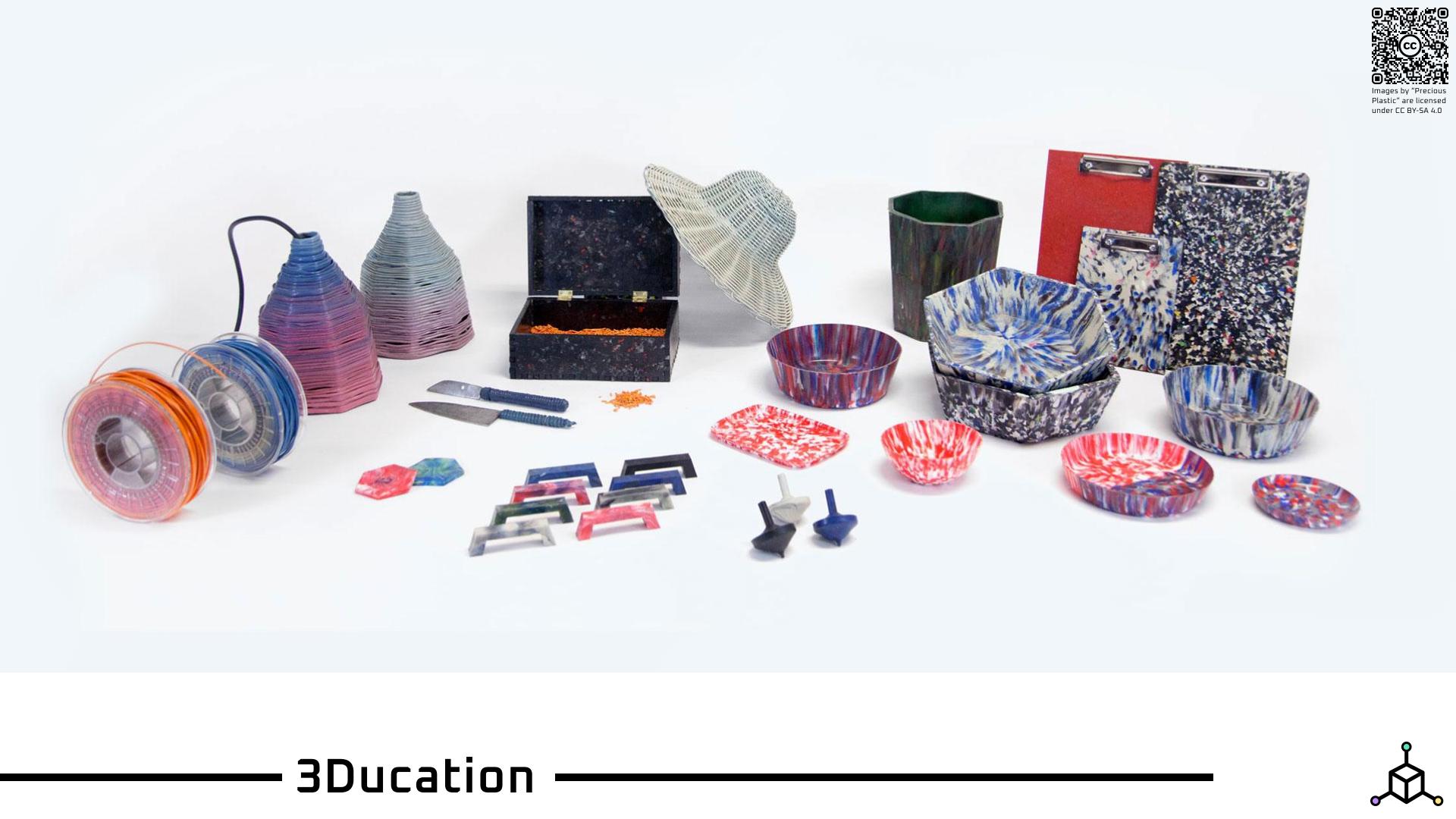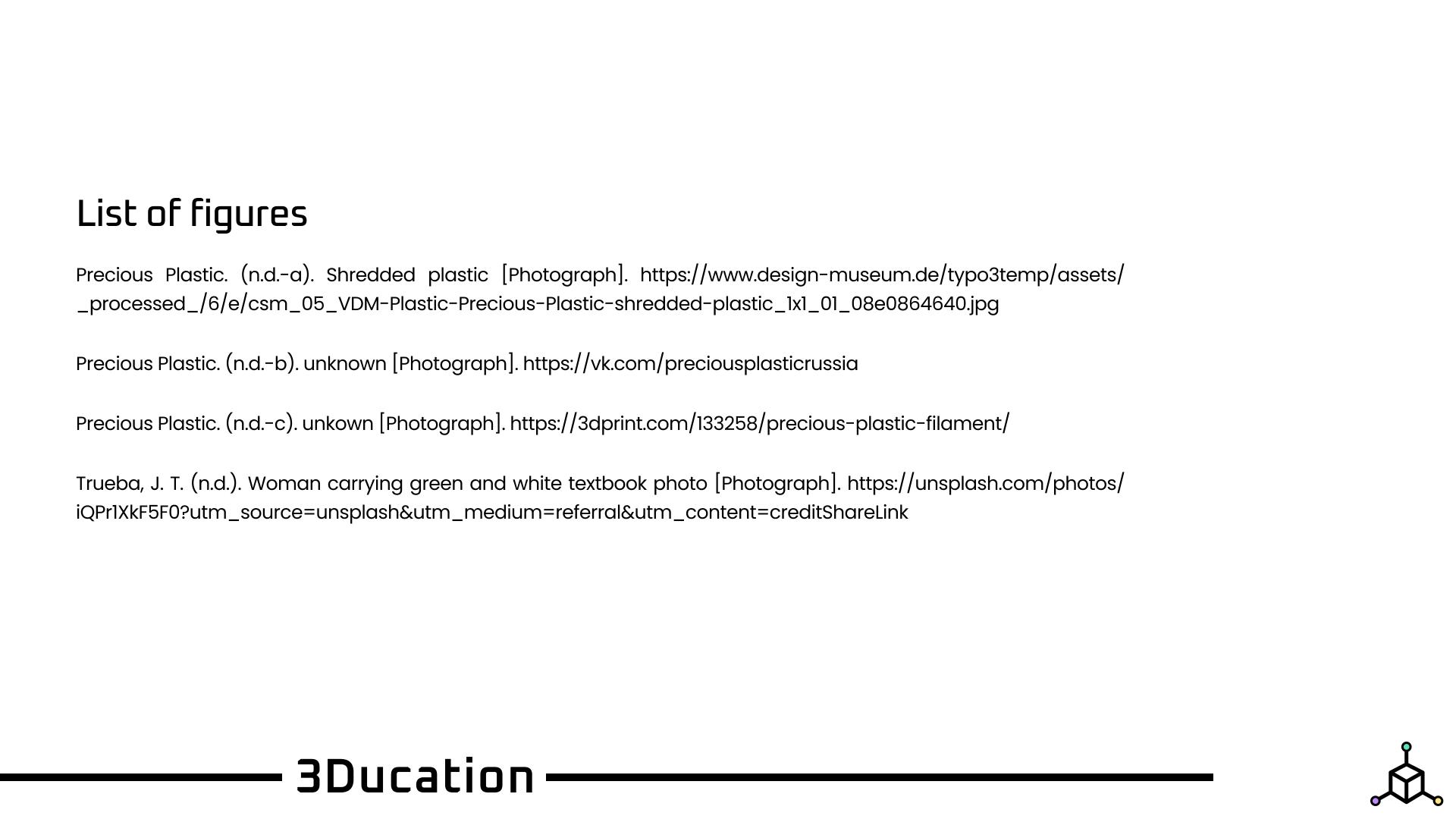3Ducation
Basic information
Project Title
Category
Project Description
“3Ducation” brings 3D printing and recycling into our schools, giving students the chance to learn about sustainability, circular economy and 3D software. We intend to establish a novel approach to education in changing the way we handle the use of plastic. Students will recycle their own plastic waste and create products that will integrate into their everyday school life while diving into the technology of 3D printing.
Geographical Scope
Project Region
Urban or rural issues
Physical or other transformations
EU Programme or fund
Which funds
Description of the project
Summary
The underlying idea of this project is to equip schools with 3D printers and plastic shredders, thus enabling students to recycle their own plastic waste and create new products out of it while simultaneously learning about 3D software, circularity, recycling and decentralised production. The project’s educational framework aims at practical and creativity-focussed learning, showing students that they can have an impact on both their immediate and future environment and that the period of use of disposable products can be easily extended.
The recycling process starts by shredding plastic waste. The outcome will be transformed into a filament which in turn will function as “ink” for the 3D printers. 3D printers can produce a variety of products that are useful for schools, such as 3D models for science classes, supplies for craftsmanship, yet also operational supplies like clocks or serving trays for the cafeteria. In a longterm perspective, the project therefore also helps schools financially since the plastic in use is waste, that is free. It further defines a school’s educational values and identity, i.e., sustainability and active participation.
The climate crisis is one of the most significant topics of our time and how we handle a product’s life cycle, i.e., its production, use and removal, defines the foundation of our future. To implement this awareness into educational infrastructure would have an enormous and positive impact on our ability to steer the development of climate change—not only combating its symptoms but preventing its causes.
Key objectives for sustainability
Humankind has produced over 8.3 billion tons of plastic and over 90% has not been recycled. This suggests the urgency to teach upcoming generations on how to manage valuable resources and to educate them on the circularity of resources. Instead of frequently buying new operating materials, schools can now produce most of them themselves. They can also print everyday objects like trash cans, crates and even chairs, and replace broken items with 3D printed objects. Furthermore, it enables students to personalise the school building by coming up with creative projects, decoration etc. Ideally, schools would set up a recycling system for the plastic waste they produce (e.g. plastic waste from the cafeteria), so that the success of this project does not rely on students bringing their own waste from home. After all, new projects should be directed toward making people’s lives easier, not more cumbersome, no matter how ethical the objective. This project is exemplary for other (educational) institutions because it demonstrates what the process of recycling plastic waste within an institution can look like. At best, this project will inspire various institutions to adopt the endeavour of appropriately handling plastic waste, especially if it has already been shown to be efficient in the past.
Key objectives for aesthetics and quality
First and foremost, our project aims to create an advanced learning experience for children. Introducing students to a topic like sustainability by giving them the possibility to produce something out of (their own) plastic waste contributes immensely to the learning experience and outcome. The project will add to the theoretical knowledge that is taught by creating a real-life experience for the students, visualising and realising how they can have an impact on the world. The project will therefore enhance and implement the theoretical counterpart to sustainability, which, on its own, can be abstract and repetitive, especially for children.
As already mentioned, the school will be able to print its own learning materials. Printing the model of an atom for physics class that students can touch, disassemble and reassemble will provide a much more interactive way of learning. The same applies to biological models of, e.g., cells or nerve endings. In arts class, the possibilities are endless, from printing simple supply objects like cups or frames to printing whole artworks. The possibilities a 3D printer provides are limitless and they encompass countless creative outcomes that can contribute to a school’s curriculum.
Furthermore, all printed products have a specific look and feel to them that is typical for 3D printed objects. To a certain degree, this streamlines the objects that are being printed and creates a universal touch and aesthetic to them while still ensuring that the objects can be individually designed for specific needs. This also potentially provides the school with a branding.
Additionally, our team intends to set up workshops explaining the basics of how 3D printing works. These workshops would incorporate the usage of the actual machines (3D printer and shredder) and the software that is required to create 3D models. We would put special focus on educating teachers on the matter to enable them to teach their newly acquired knowledge to students.
Key objectives for inclusion
Our project aims for interdisciplinary applicability, giving students from different social, ethnical and economical backgrounds the opportunity to design their environment with plastic waste that they have brought from home. Because people all over the world from different social and cultural backgrounds use plastic, the project will be very open for any student to participate. On the off chance that this is the case, schools will also recycle their own plastic waste providing every student with a chance to use the 3D printer. The project is exemplary in terms of affordability, as no student has to invest any money. After buying the 3D printer and shredder, the project will sustain itself perpetually, so everyone can participate. 3D printing is also ideal for collaborative working experiences. The students can be given tasks that revolve around solving concrete problems or can focus more on creativity. Whatever form this will take, it will be easy and beneficial to integrate teamwork. How exactly this teamwork will be implemented will most likely differ from school to school depending on teaching style and age range. With respect to accessibility, 3D printing provides a huge possibility, since students and teachers decide on what they want to produce. They can adjust the properties and features of the printed objects to their needs and make sure accessibility standards are met. Generally speaking, this is also a good opportunity to educate students on accessibility and its importance for an inclusive society. The project proves that providing an up-to-date education does not have to be expensive or hard to implement. Our project provides an inclusive framework for students that can be exemplary for other schools and educational institutions.
Physical or other transformations
Innovative character
Students are offered a wide range of learning opportunities. The knowledge gained goes far beyond sustainability as students go through the entire process from recycling to the use of the products, with aesthetics and quality playing a major role. All students can participate and will have the opportunity to experiment with future- leading technologies, which creates an inclusive learning environment. The project shows that expensive technologies are not only accessible to high-income families but to everyone.
The project is a win-win situation for schools. On the one hand, it brings long-term financial benefits, while, on the other hand, it provides extraordinary and inclusive educational benefits, while also being sustainable itself.
We show in an exemplary way how one can achieve an inclusive and aesthetics-focussed education about sustainability without being dependent on an unrealistic budget.




